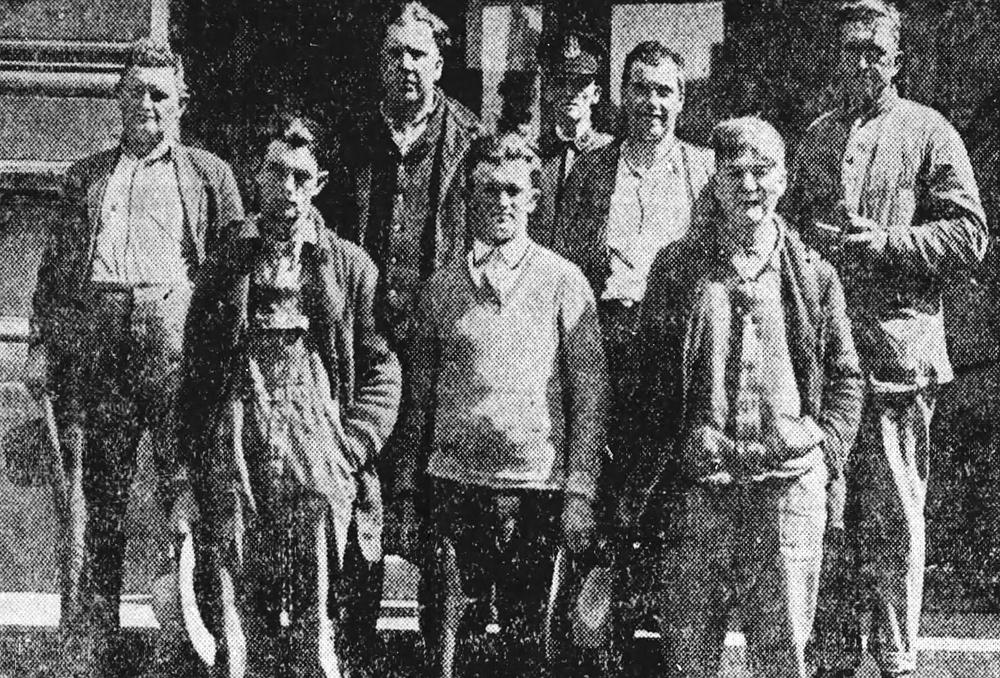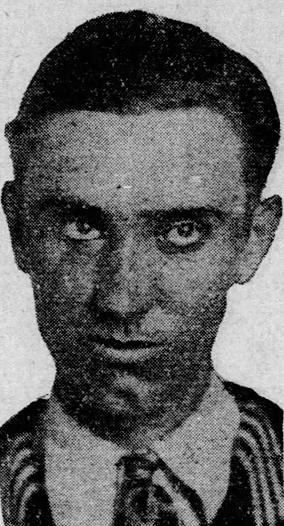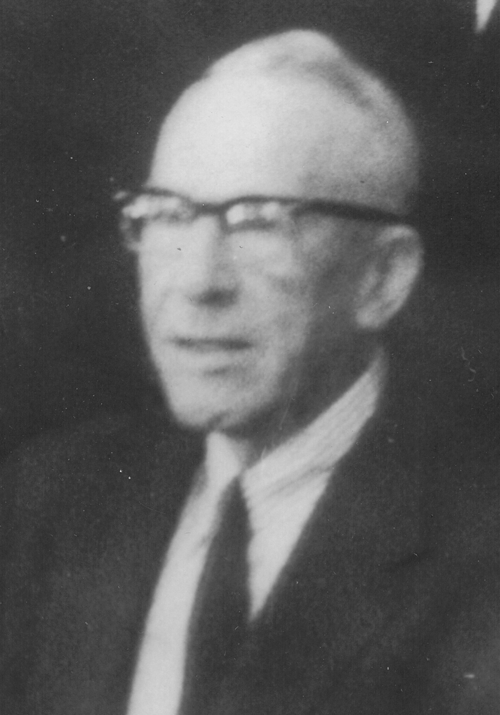
The following article by Charles Hartley was originally published in The Pioneer News on 14 Mar 2024.
In late July 1929, County Attorney T. C. "Tot" Carroll stood before the jury in the trial of Will Barnett and Wallace Ellis for the murder of Dee Disponett, an Anderson County native who had been killed in Bullitt County just north of Mt. Washington.
His voice rising in apparent anger, he charged,
"They call our county 'Bloody Bullitt' because it has been made the dumping ground for criminals from Anderson, Jefferson and other counties who come here and commit crimes!"
Facing the jurors, he declared that such conditions existed because juries had been too "weak-kneed" to send criminals to the electric chair, and he encouraged them to see that this was what these men received.
Carroll's office had been busy over the last fourteen months, dealing with three separate murders scattered about the county. The first occurred the first weekend of May 1928 when Kate Browning was killed in the Browningtown area; the second when a Cupio merchant named William Close was killed by robbers in mid-December; and the third when the murdered body of Dee Disponett was discovered near Mt. Washington in late April 1929.
It all began in the Fall of 1927 when Sheriff Frank Monroe approached Carroll and the County Judge about what to do with four vagrant children. Little did Carroll know that the result of their efforts to care for the kids would result in a murder charge against a number of local men.
Monroe and Clarence Crenshaw, a local resident, had been in the Cedar Grove neighborhood pursuing an unrelated civil case when they came across the kids and a couple of adult relatives living in a destitute state, huddled around a small stove in an old barn and without provisions.
A decision was made to remove the kids from their mother and place them in an institution of care. Monroe and John Bolton, the magistrate for that district, returned to the barn and collected the kids despite the protests of their mother, Amanda Jones.
Up until this time, most of the criminal cases that Tot Carroll had seen were related to prohibition violations.
The demand for whiskey and other distilled spirits had not dwindled; if anything, making it illegal had increased the demand, a lesson the nation would eventually learn. But for now, many farmers were eager to supply the grain and even distill the illegal whiskey to survive economically.
Moonshiners and bootleggers, without the protection of the law, had to protect themselves as best they could, and this meant meeting violence with violence. Men who, in another time, would have respected the law and its protections, now took the law into their own hands to protect themselves.
When Amanda Jones failed to get her kids back, she decided to get even with John Bolton and Clarence Crenshaw, men she mistakenly blamed for the loss of her children.
She and her mother informed Federal agents about a moonshine still being operated in a nearby hollow by Elmer Crenshaw, Clarence's son. After the still was raided and Elmer arrested, word spread quickly as to who was responsible for the raid.
Without going into details (which may be found in the book titled The Browningtown Massacre, available at the History Museum or online at Amazon), a group of locals attacked the shack where Amanda and her siblings, and her mother and aunt were living, setting it afire and firing shotgun blasts as the family fled.
The result was the death of Kate Browning, Amanda's aunt. The family insisted that they recognized either the faces or voices of ten members of the mob that had attacked them. Federal prohibition officers quickly became involved in the case, and soon warrants were issued.

Later a jury's verdict would sentence Clarence Crenshaw, Elmer Crenshaw, John H. Bolton, Frank Hodge, Selby Hodge, Les Hodge, Golden Hodge, Jim Harris, and Frank Kinder to life behind bars for her death.
On defense motions, the judge granted Golden Hodge, Les Hodge and Jim Harris new trials which were scheduled for the April 1929 court term. The three asked for separate trials, and Jim Harris would go first.
The remaining defendants had appealed their convictions to the Court of Appeals, and Carroll was among those who were busy preparing for that when a second murder took place on December 15.
William Close ran a store at Cupio near the Bullitt County line. From newspaper reports it appears that several men called Close from his home to sell them some gasoline, and his wife heard shots and found her husband shot.
Our earliest record for William in Bullitt County was when he married Seivilla Chappell in May 1901. At that time he was a Hardin County merchant. Prior to that he was born in Green County, and had been married twice before; once in Green County to Nannie Marcum, and then in Larue County to Leora Noe who bore him two children, George and Flora. Both marriages ended in divorces.
Sometime after marrying Seivilla, he established his store in Cupio where we find him in the 1920 census. By this time, he had already lost his son George to a railroad accident in Illinois in 1914. By April 1926, he felt the need to write a will in which he left his estate to his wife, with the stipulation that it would next go to his daughter Flora Bishop and her children. Little did he know that his life would be cut short before long.
With Bullitt County's law enforcement officers spread thin, the Cupio community turned to Jefferson County police for help in finding William Close's murderers. The case was unsolved until April 1929, when Captain Ambrose Hagerman and Patrolmen Arthur Hagerman and Carl Horn arrested Sam Heddon of Ohio County based on an anonymous tip. Heddon confessed and implicated Clarence Hines, a railroad crossing watchman near Cupio.
About that time, a jury impaneled from Jefferson County found Jim Harris guilty of Kate Browning's murder and he was sent to prison. New trials for the two remaining Hodges were scheduled for the July term at Shepherdsville.
Meanwhile, police had arrested Harvey Felker in connection with William Close's death. This followed the arrest of Hines who confessed to the killing and implicated Felker as well.

Not only did Carroll and his fellow court officials have the first two murders to deal with that April, a third victim was discovered, Dee Disponett of Anderson County who was discovered in a field north of Mt. Washington. He had been missing since April 9, having left his home near Lawrenceburg with two other men for Louisville, Wallace Ellis and William Barnett. When his body was discovered, warrants were issued for their arrest.
It was reported that Disponett had recently sold some sheep, and reportedly was carrying about $700 at the time of his disappearance.
On July 13, a newspaper reported that T. C. Carroll was busy with preparations for the second trials of Leslie and Golden Hodge in the mob slaying of Kate Browning, and also with the grand jury investigation of the other two killings. Circuit Judge Basil Richardson and Commonwealth Attorney E. W. Creal expected to seek indictments against those charged in the latter two murders. They planned to bring all of them to trial in July.
However, with such a full docket, Creal moved that the trials of the two Hodge boys be moved to the November docket.
Clarence Hines came to trial first, on July 19, and was found guilty of killing Close. Then on the 22nd, Sam Hedden pled guilty as well. Then two days later, a jury brought back guilty verdicts for both Barnett and Ellis in the murder of Disponett.

Felker's trail was held next. His lawyer presented evidence in an attempt to show that Felker was somewhere else at the time of the murder. The jury was convinced, and Felker was acquitted.
T. C. Carroll faced re-election that fall, and was defeated by A. E. Funk who would go on to serve as State Attorney General under Governor Earle Clements. After dealing with multiple murder cases, I'm not sure but what he may have been secretly happy to have lost the race.
By this time, many who had been involved in prosecuting in the Browning case were having second thoughts. A petition brought by Selby Hodge's sister to obtain his release was supported by Carroll and others on the grounds that he had likely not been involved. Then, by 1935, most of those found guilty in that case had been paroled.
Tot Carroll would go on to serve in the Kentucky Senate from 1941-45, and frequently was called upon to serve as a special Circuit Court judge. He died in 1978, age 88, having served his community well.
Copyright 2024 by Charles Hartley, Shepherdsville KY. All rights are reserved. No part of the content of this page may be included in any format in any place without the written permission of the copyright holder.
The Bullitt County History Museum, a service of the Bullitt County Genealogical Society, is located in the county courthouse at 300 South Buckman Street (Highway 61) in Shepherdsville, Kentucky. The museum, along with its research room, is open 10 a.m. to 4 p.m. Monday through Friday. Saturday appointments are available by calling 502-921-0161 during our regular weekday hours. Admission is free. The museum, as part of the Bullitt County Genealogical Society, is a 501(c)3 tax exempt organization and is classified as a 509(a)2 public charity. Contributions and bequests are deductible under section 2055, 2106, or 2522 of the Internal Revenue Code. Page last modified: 12 Sep 2024 . Page URL: bullittcountyhistory.org/memories/murder-three.html